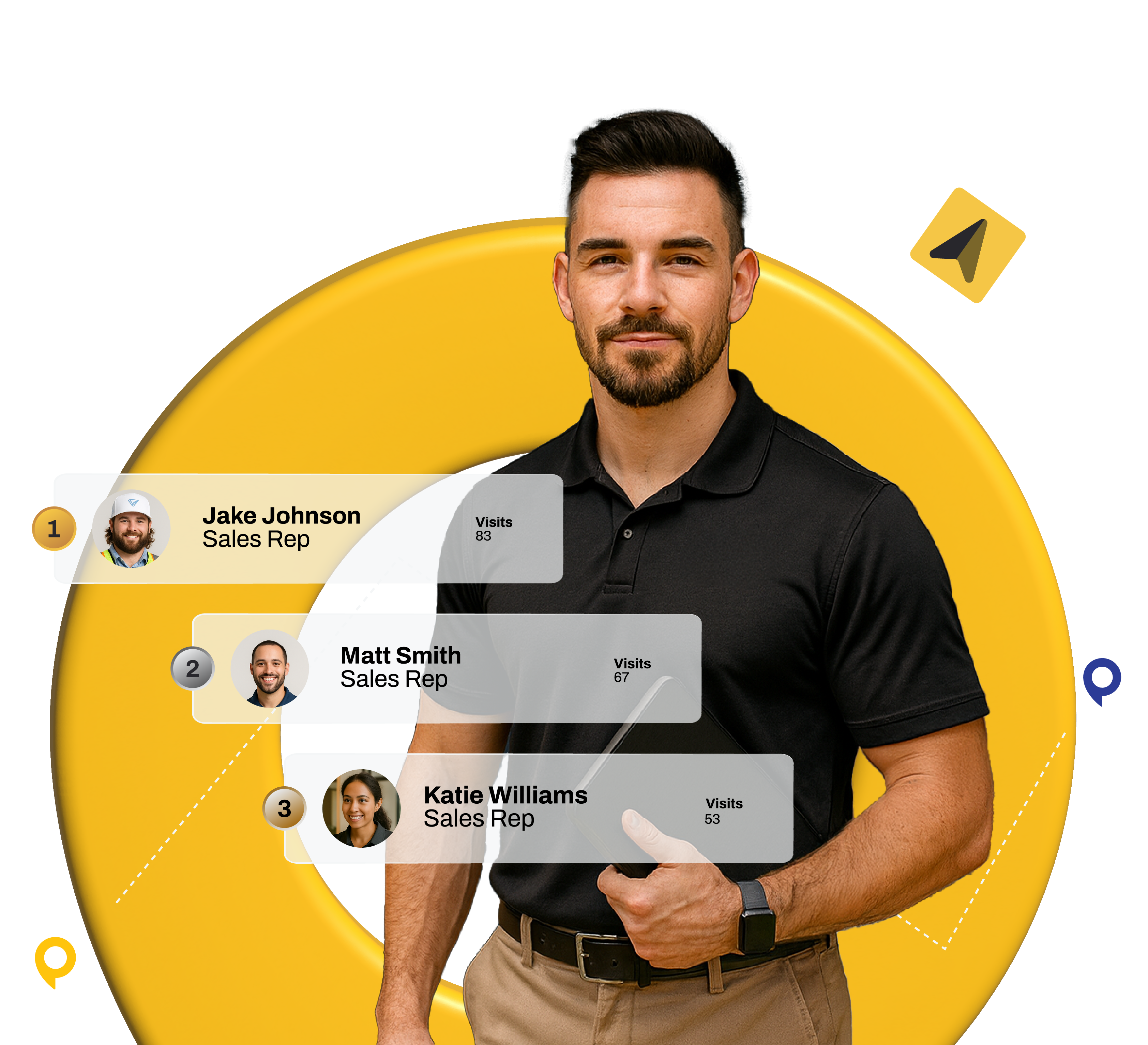While everyone’s obsessed with LinkedIn and Zoom calls, door to door sales is quietly commanding a $208.5 billion global market—projected to hit $269.2 billion by 2029. D2D converts at 2-5% compared to just 1% for digital channels, because face-to-face selling builds trust faster when you’re asking someone to invest in solar panels, a new roof, or a security system. For field sales managers, D2D success comes down to three things: the right people, proven playbooks, and tech that doesn’t get in the way.
This guide delivers field-tested strategies for hiring, training, and scaling door to door sales teams that consistently hit quota.
What Is Door to Door Sales?
Door to door sales is the process of canvassing territories and meeting face-to-face with potential customers to explain product benefits, answer questions, and close deals on the spot.
B2B vs B2C D2D Sales
In B2B contexts, reps visit businesses to speak with decision-makers, schedule follow-up appointments, or leave sales materials. The goal is often relationship-building and multi-touch engagement.
B2C salespeople target residential neighborhoods, knocking doors to speak directly with homeowners. Reps often use social proof—mentioning that a neighbor just purchased—to build credibility and urgency at the door.
Core Pillars of D2D Sales
Effective door to door sales processes are built on five pillars:
- Prospecting is finding new customers to keep your pipeline full. Without a steady stream of prospects, growth stalls.
- Qualifying means identifying whether a prospect’s needs match what you offer. You’re looking for three things: pain (enough discomfort to motivate change), budget (money to buy), and decision power (authority to say yes). This requires asking open-ended questions, listening carefully, and reading between the lines.
- Pitching is when you explain how your product solves their specific pain points. Skip the generic benefits—focus on what matters to this prospect based on what they just told you.
- Closing is convincing the prospect to buy right now. There are dozens of closing techniques, and the best reps know which approach works for different personality types and situations.
- Follow-up happens after the sale to ensure customers received what they ordered and are satisfied. It’s your gateway to referrals, upsells, and repeat business.
Why Door to Door Sales Still Works in 2026
D2D isn’t dying—it’s evolving. The market is growing at 6.6% annually, and 90% of companies now use hybrid field sales models that blend digital tools with face-to-face selling.
Higher Conversion Rates Than Digital
Door to door sales converts at 2-5% compared to 1% for digital channels. When you’re standing in someone’s driveway explaining how solar panels will cut their electric bill in half, you can handle objections instantly. Digital ads can’t do that.
Industries Where D2D Dominates
Solar energy, roofing, home improvement, alarm systems, and telecom services all rely heavily on D2D because these products require detailed explanations, trust-building, and often on-site assessments. Top performers in solar canvass areas three times to reach 90% of homeowners, yielding one qualified lead per 50 knocks.
Managing Door to Door Sales Teams
A door to door sales manager isn’t just a supervisor—you’re a strategic leader who sets territory assignments, coaches reps through rejection, and turns field data into actionable playbooks.
The Sales Manager’s Strategic Role
Your job is to connect daily canvassing to revenue targets your CEO actually cares about. That means:
- Resource allocation: Don’t assign a rep 40 miles of rural territory and expect the same output as a dense suburb. Use account density, average deal size, and rep capacity to balance workloads fairly.
- Coaching that sticks: Training isn’t a one-time event. Top managers run weekly role-plays, review recorded pitches, and ride along to spot what’s actually happening at the door.
- Data-driven decisions: Track doors knocked, contact rates, conversion rates, and average deal size. When a rep’s conversion rate tanks, dig into why—bad territory assignment, weak pitch, or just a rough week?
Build Territory Management Systems
Fix your territory assignments before you do anything else. Map where reps are actually spending windshield time, then look for gaps where business accounts and residential neighborhoods overlap poorly.
Use market data to identify high-potential territories. Consider demographics, household income, homeownership rates, and competitor saturation. Territory management software visualizes this data on interactive maps so you can spot opportunities fast.
Balance workloads so every rep has similar opportunity. If one rep’s territory has 2,000 qualified households and another has 500, your close rate comparisons are meaningless.
Set Clear Targets and KPIs
Top performers average 50-70 doors knocked per day. Set activity targets (doors knocked, conversations held, demos completed) alongside outcome targets (deals closed, revenue generated). Activity metrics tell you why outcomes are trending up or down.
Track these KPIs weekly:
- Contact rate: Percentage of knocks that result in conversations
- Conversion rate: Percentage of conversations that become sales
- Average deal size: Revenue per closed deal
- Pipeline velocity: Days from first contact to close
Hiring and Training D2D Teams
What to Look For When Hiring
Look for persistence, communication skills, adaptability, and a positive attitude. During interviews, run scenario-based role-plays. Hand the candidate a product sheet and say, “I just told you I’m not interested. What do you say next?” Their response tells you more than any resume.
Decide early whether you want experienced or inexperienced reps. Experienced canvassers deliver leads immediately but may bring bad habits. New reps take longer to ramp but you can train them exactly how you want them to work.
Interview at least five candidates before extending an offer. Source from LinkedIn, Indeed, ZipRecruiter, and your professional network.
Structure Your Onboarding Process
Set new hires up for success with a structured onboarding timeline:
Week 1: Product training, pitch framework, territory overview, CRM setup, shadowing top performers
Week 2: Co-selling with manager (you knock, they observe; then they knock, you coach)
Week 3: Independent selling with daily debriefs
Week 4+: Full territory ownership with weekly one-on-ones
Provide territory maps, product materials, objection-handling scripts, and access to sales enablement tools from day one.
Ongoing Training That Works
Run weekly role-plays where reps practice handling common objections. Record pitches (with customer permission) and review them as a team to identify what works. Share wins publicly—when a rep closes a tough deal, have them walk the team through exactly what they said.
Leverage Technology for Field Sales
Modern field sales managers rely on technology to optimize every aspect of D2D operations. The right tools don’t just save time—they uncover patterns that turn average reps into top performers.
Territory Management Software
Territory management software lets you define territories by geography, ZIP code, account type, and custom criteria. You can set user permissions so reps only see their assigned accounts, then pull analytics on every territory to spot underperformance early.
Sales Automation and Productivity
Automating routine tasks can increase rep productivity by as much as 46%. SPOTIO users report this productivity gain from features that automate CRM data entry, activity logging, and daily route planning—plus AutoPlays that guide reps through follow-up sequences once prospects are enrolled.
Field force automation boosts productivity by 23% and can increase sales by 30%. Route planning specifically increases daily meetings by 30-40% by eliminating inefficient drive patterns.
CRM Integration and Data Insights
Manual data entry kills productivity. With seamless CRM integration, notes and activities logged in the field sync to your CRM through real-time, bi-directional integration. Reps always work with current information, and managers get instant visibility into field activity.
Analyze close rates, outreach volumes, and field notes to inform ongoing strategy. When Chipr’s leadership implemented systematic activity monitoring through SPOTIO, they achieved their 6% close rate targets by identifying which approaches generated highest conversions—then scaled those techniques across their entire team.
Common D2D Sales Challenges
High Turnover
Sales rep turnover averages 35%—nearly three times higher than other industries. High turnover destroys institutional knowledge and forces you to constantly train replacements.
Fix it: Invest in better hiring (use scenario-based interviews), build a strong team culture (celebrate wins publicly), create clear career paths (show reps how to move into management), and recognize top performers (leaderboards, bonuses, President’s Club trips).
Inconsistent Messaging
When every rep pitches differently, you can’t identify what actually works. Inconsistent messaging also confuses prospects and damages your brand.
Fix it: Provide standardized pitch frameworks (not rigid scripts) that outline key talking points, objection responses, and closing questions. Run weekly role-plays and record pitches to reinforce messaging. Review recorded calls as a team to identify best practices.
Prospecting Fatigue
Knocking 50-70 doors per day is physically and mentally exhausting. Reps burn out fast when they’re constantly hearing “no” without visible progress.
Fix it: Rotate territories to keep things fresh. Implement leaderboards and incentive programs that reward daily wins, not just closed deals. Create a culture where reps share wins with the team—seeing others succeed reminds everyone that the grind pays off.
Essential Tools for D2D Managers
Territory Management
Territory management software allows you to define strategic territories by geography, ZIP code, demographics, and custom filters. You can set parent and child territories, assign user permissions for territory views, and pull detailed analytics for every territory to identify underperformance.
Sales Leaderboards
Sales leaderboards encourage healthy competition between reps and boost engagement in contests and incentives. Real-time rankings motivate underperforming reps to close the gap and keep top performers pushing for higher numbers.
Rep Tracking
Rep tracking tools show you where reps are through location-verified activities. Reps drop pins on a map at each visit, so you can see the exact time of every sales call, how long they met with a contact, and whether they completed their route for the day.
Sales Tracking
Sales tracking offers management and operations key insights into rep and territory performance. Track activity metrics (doors knocked, conversations held, demos completed) and outcome KPIs (deals closed, revenue generated, conversion rates) in real-time dashboards.
Essential Tools for D2D Sales Reps
Route Planner
A route planner optimizes route efficiency so you make the most of your time in the field. SPOTIO’s route planning feature calculates optimal routes based on planned stops, calculates mileage based on route distance, and syncs completed routes to your CRM.
Lead Machine
SPOTIO Lead Machine lets sales teams import existing residental customers and prospects, color-code map pins based on account type, and filter leads by 15 data points including property details, demographics, and geography. With the mobile app, reps can tap businesses on a map to pull contact info from Google Places while in the field, or use Lead Machine to discover B2C residential prospects.
Appointment Setting
You need technology that makes it easy to schedule appointments for yourself or other team members. SPOTIO’s appointment setting feature lets you see everyone’s schedule and book demos or appointments from your mobile device while standing in a prospect’s driveway.
Customer Mapping
A customer mapping solution takes complex data from your CRM and compiles it into an easy-to-view interactive map. Zoom in on a territory, tap a pin, and see all prospect information and rep activity at that location.
AutoPlays
AutoPlays guide reps through next actions based on where prospects are in the pipeline. They eliminate the need to manually track when to follow up or what activity comes next. Reps enroll prospects in AutoPlays, and the system deploys the right activity—text, email, visit, or call—at the right time, keeping prospects engaged and leads moving through the pipeline.
CRM Integration
Manual processes drag productivity down. With CRM integration, any notes or data reps log while canvassing sync to your CRM through real-time, bi-directional integration, ensuring sales reps always work with the most current information.
Top Industries Using D2D Sales
Solar Energy
Door to door sales of residential rooftop solar panels works well because the product is complicated and best explained in a one-on-one, in-home consultation. Reps can assess roof viability on the spot and provide instant savings calculations.
Roofing
Roofing is expensive, and homeowners are more likely to purchase a new roof when a rep explains the benefits—and risks of waiting—in person. Storm-chasing roofing reps canvass neighborhoods after hail damage to offer free inspections.
Home Improvement and Home Services
Door to door sales works well for home improvement and home services because reps can demonstrate how homeowners can upgrade or maintain their homes. Reps also know they’re speaking with decision-makers when they meet with homeowners, and can typically qualify leads within minutes.
Alarm/Security
Alarms and security systems that protect property are best explained in person. Reps can walk the property, identify vulnerabilities, and tailor the system to the home’s specific layout.
Telecom
Canvassing efforts work well for sellers of telecommunications services because they can offer persuasive reasons to switch from a current provider. Social proof works particularly well in telecom—mentioning that a neighbor already switched builds credibility fast.
11 Traits of Successful D2D Sales Reps
Successful door to door sales professionals share these traits:
- Product knowledge inside and out. You can’t explain features and benefits if you don’t thoroughly understand what you’re selling.
- Expertise that provides value. Customers research online before you knock. If you tell them what they already know, you’re wasting their time. Educate prospects about what they can’t discover on their own.
- Rapport. Top performers have excellent emotional intelligence and find connections with people naturally. Others research prospects beforehand to find common ground.
- Prospect qualification. The best reps ask open-ended questions to gather information, then use close-ended probes to establish specific needs.
- Listening. After asking a question, top reps actively listen—not planning their next pitch while the prospect talks.
- Empathy. The most successful reps understand the prospect’s needs and explain how their product solves that specific problem—not a generic list of features.
- Expectation management. Top salespeople outline what happens next at every stage. Create a verbal agreement that explains what will happen in the call, during the sale, and after installation.
- Trust-building. Honesty builds trust. Reps who explain what the prospect will experience before, during, and after the sale establish credibility fast.
- Time management. Successful reps are strategic about prospecting. They call on current customers for referrals, focus on high-probability prospects, and don’t waste time on leads that won’t convert.
- Closing. Knowing how and when to close is critical. Not all customers respond to the same approach, so understand what appeals to your target audience and match your closing technique to their personality.
- Record-keeping. Successful reps keep detailed notes about potential customers, pain points, and meetings. This information helps build rapport over time and move prospects through the sales funnel.
10 Door to Door Sales Tips to Crush Quota
Master Your Product
Why this matters: You can’t sell what you don’t understand. Prospects ask tough questions, and fumbling for answers kills credibility instantly.
Tip: Practice explaining your product’s features and benefits to someone who knows nothing about it—a friend or family member. Ask them what questions they have and if your explanation made sense. If they’re confused, prospects will be too.
Prospect Efficiently
Why this matters: Qualified prospects close faster and generate more revenue. A solid lead qualification process means you’re not wasting time pitching to someone who can’t or won’t buy.
Pro Tip: Ask your satisfied customers for referrals. They want to help you, and they’re likely to refer people who actually need your product—not random contacts who’ll brush you off.
Find the Pain
Why this matters: When the pain of change is less than the pain of the status quo, prospects buy. Sometimes prospects don’t realize a better alternative exists until you show them.
Pro Tip: Ask questions about how their challenges affect productivity, resources, or costs. When they start quantifying the impact, they begin to recognize the importance of solving it.
Pay Attention to Body Language
Why this matters: People communicate with far more than words. Recognizing visual cues tells you whether your pitch is landing or falling flat.
Pro Tip: Know your pitch so well that you can deliver it while simultaneously reading the prospect’s signals. Watch facial expressions, body position, and breathing patterns to discern whether they’re warming up or giving you the cold shoulder.
Pitch Perfectly
Why this matters: Prospects form impressions fast. You need to communicate what you’re selling and present your best information in the first 30 seconds.
Pro tip: Structure your pitch in four steps: introduction, questions, presentation, and close. Introduce yourself and your product while making eye contact and smiling. Ask open-ended questions and let them talk. Present with the most relevant information first, keeping it short. Finally, ask for their business.
Get to the “No” Faster
Why this matters: Many people are too polite to say “No,” and they’ll let you pitch even when they have zero intention of buying.
Pro tip: Give them permission to dismiss you early. Try this: “If at any point you feel what I’m offering isn’t valuable to you, just tell me. You won’t hurt my feelings, and I don’t want to waste anyone’s time.” Prospects appreciate the honesty, and the ones who stick around are actually interested.
Build a Sales Script
Why this matters: Knowing what you’re going to say and what you need to find out keeps you calm and on track during cold calls.
Pro tip: Take notes about your calls as you work. Over time, you’ll see what qualified leads had in common. Use that information as the basis for your script—include your introduction, pitch, and questions you use to qualify leads.
Handle Objections with LAER
Why this matters: Objections are the reasons prospects have for not buying. Your job is to determine if the objection is really a “No” or just an obstacle to overcome.
Pro tip: Use the LAER model: Listen, acknowledge, explore, and respond. Pay attention to their objection, acknowledge that you understand it, ask why they feel that way, then reply with empathy and an explanation that might resolve their concern.
Analyze Your Data
Why this matters: Data helps you identify weak points in your process. If you’re knocking 60 doors but only closing one deal, something in your pitch or qualification process needs fixing.
Pro tip: Keep a record of daily activity—doors knocked, people talked to, demos performed, and units sold. Analyze your results weekly to look for patterns. If your demo-to-close rate is low, work on your closing technique. If your door-to-conversation rate is low, refine your opening hook.
Never Skip Follow-Up
Why this matters: Many sales reps fail to follow up consistently, costing them deals. Most deals require multiple touches before a prospect commits.
Pro tip: Use an appointment app or CRM to organize your call-back schedule. Capture prospect email addresses so you can add them to follow-up sequences. SPOTIO’s appointment setting feature lets you capture lead notes, input contact details, and view, set, and manage appointments from the field. Once logged, everything syncs to your CRM so you don’t re-enter data at the end of the day.
FAQ
What are the pros of door to door sales?
Door to door sales builds relationships that digital channels can’t replicate, which is critical when selling high-value items like solar panels, roofing, or security systems. D2D converts at 2-5% compared to 1% for digital channels because face-to-face interaction builds trust faster. Reps can handle objections instantly, assess property suitability on the spot, and tailor their pitch based on real-time feedback. The global D2D market reached $208.5 billion in 2025 and is projected to grow at 6.6% annually through 2029.
What are the cons of door to door sales?
Door to door sales is physically demanding—reps knock 50-70 doors per day on average—and rejection rates are high. Turnover averages 35%, nearly three times higher than other industries. Reps could accidentally knock on prospects who’ve already been contacted by another team member, but territory mapping software prevents this. Weather, homeowner availability, and unpredictable schedules make D2D less predictable than inside sales.
What’s the average conversion rate in D2D sales?
The average conversion rate for door to door sales is 2-5%, depending on factors like product complexity, price point, competition, and market conditions. This is significantly higher than digital channels, which typically convert at around 1%. Top performers in industries like solar canvass areas three times to reach 90% of homeowners, yielding approximately one qualified lead per 50 knocks.
How much can you make in door to door sales?
Door to door sales earnings vary widely based on experience, industry, and compensation model. Entry-level reps earn $20,000-$30,000 in their first 3-4 months. Mid-level reps make $70,000-$100,000 annually. Top performers earn $250,000-$1 million or more. Average base salary ranges from $56,000 to $95,000 depending on location and industry. Most D2D positions include commission, so earnings are heavily tied to performance.
What compensation models work best for D2D teams?
- Commission-only: Best for self-motivated independent contractors who want unlimited earning potential. Reps earn a percentage of every sale with no base salary.
- Gross margin commission: Reps earn commission on the profit generated by each sale, not the total sale price. This aligns rep incentives with company profitability.
- Tiered commission: Reps earn higher commission rates once they exceed certain sales thresholds. For example, 5% on sales up to $10,000, then 8% on anything above that. This structure motivates reps to push past minimum quota.
Most successful D2D teams use tiered commission structures with a modest base salary to balance income stability with performance incentives.
Five Non-Negotiables for D2D Success
- Recruit strategically. Look for candidates with strong interpersonal skills and resilience. D2D selling isn’t for everyone—selecting the right talent from the start reduces turnover and builds a positive team culture.
- Prioritize coaching. A well-prepared rep can adapt to unexpected questions or objections. Regular coaching, role-playing scenarios, and skill refreshers turn average performers into top sellers.
- Set measurable goals. Define KPIs like doors knocked, conversations held, and conversion rates. Tracking these metrics keeps your team focused and helps you identify improvement areas before they become problems.
- Encourage accountability. Implement performance dashboards and regular check-ins. When team members understand how their actions connect to revenue targets, accountability—and results—improve.
- Promote continuous learning. Share best practices, host team debriefs, and encourage knowledge exchange. High-performing door to door sales teams learn from every success and setback, then scale what works across the entire organization.
Markets shift, customer preferences evolve, and competitive landscapes change. A successful field sales manager never stops learning, adjusting, and striving for continuous improvement—setting the stage for consistent success in door to door sales.
SPOTIO is field sales software built for teams that sell face-to-face. Chipr achieved their 6% close rate targets using SPOTIO’s activity monitoring and data-driven coaching tools. Hadco Metal Trading streamlined territory planning and boosted efficiency with SPOTIO’s interactive mapping and task management.
Want to see how SPOTIO can take your D2D team to the next level? Request a demo.




